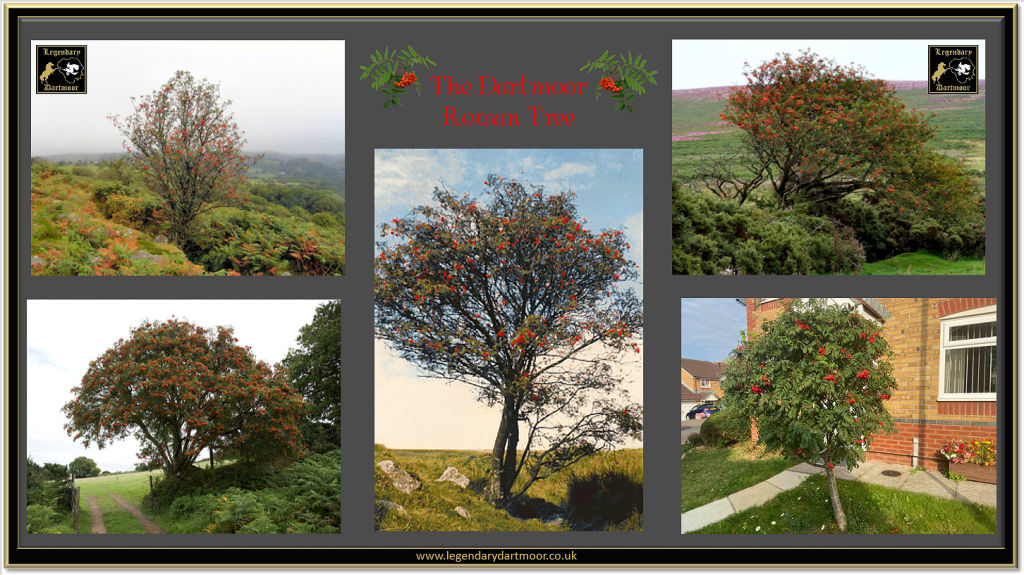
“The great, solitary rowan-tree did much good, for it gave a welcome shade to the cattle and the traveller ; it broke the line of the level fiat gratefully, it offered pleasure to the eye at bud-break and sparkled with bunches of scarlet fruit in the autumn, which both gladdened the spectator and fed the missel-thrushes. But the good it did was all in the day’s work and came of no effort, no self-denial. The mountain ash was intent on his own business and prosperity alone.” – Eden Phillpotts, A Shadow Passes, pp. 59 – 60.
If I had to chose one tree on Dartmoor as a symbol for the moor it would be the brave little Rowan Tree. Most years some calendar will show an autumn picture of a little stream tumbling off the fen and stood beside it will be a quickbeam laden with crimson berries. They are always pictured against a blue sky and present the typical ‘moorland scene’. But the quickbeam can brighten up the most dismal of days, when everything is shrouded in rolling mist, the brown damp bracken providing a semblance of colour, all of a sudden a quickbeam comes into view and its blood red berries seem to light up the landscape.
Sorbus aucuparia L. is probably best known as the Rowan or Mountain Ash, on Dartmoor it is called the Quickbeam or Witchbeam. The old Anglo Saxon word cwictrēow was used for a rowan tree and the word wicce meant a witch which led to the connection that the tree provided protection from witches. The botanical name is derived from Sorbus which ancient writers used to describe the Service Tree, later taken as the whole tree genus. Aucuparia comes from avis – bird and capere – to catch, this was because wildfowlers used the berries as bait in their traps. It was said that the berries intoxicated the birds and made them easier to catch, indeed another old name for the tree was ‘Cock-drunks’. The tree is deep rooted in folklore and there is a tradition that the first rowan tree grew from a berry dropped by the ‘Tuatha Dé Dannan’ who were an early Irish Celtic tribe. The quickbeam became a sacred tree which was later adopted into Christian belief where it was supposed to stop the dead from ‘walking’ and to provide protection from evil. The old word quick used to mean alive as in the ‘quick and the dead’ and it is this connotation that survives in the word ‘quickbeam’. There are several ‘quickbeam’ place-names on the moor such as Quickbeam Hill and Quickbeam Foot.
It was traditional to hang a branch of quickbeam over the doors of the cotts to ensure that no witch could cause any harm to those living under its protection. For even better protection a whole tree would be planted near to the house or cott, hence the saying – “Rowan tree and red thread, Hold the witches all in dread.” It is interesting to see the number of quickbeams planted in today’s modern housing estates. I’m not saying I believe in these traditions but as you can see below we have planted one outside the house. When away from the house people would carry in their pockets a small cross made from quickbeam and tied with red thread. The reason for using red thread was because it was thought to enhance any ‘magical power’ of anything it was tied to. Caters and waggoners of old would use a whip or goad made from quickbeam as it was said to control the horses better, another saying was – “If you whip stick is made of rowan, you may ride you nag through any town.” However, it should never be used to ‘fight’ (a term for beating) a horse with a rowan stick as disaster would surely follow and similarly ill-fortune would bestow itself on any person breaking a rowan bough. There is also a tradition that anybody who carries a walking stick made from Quickbeam will never get lost and I must confess that when I am out walking I always carry such a stick. If an animal grew sick then it was thought that a ‘collar’ of quickbeam would stop the condition worsening. Sprigs would also be hung in the dairy to stop the milk from curdling, this probably stems back to the belief that witches could curdle the milk if they were feeling ‘murdy maakin’ (mischievous). Some carpenters would also incorporate some quickbeam wood into a child’s cradle for protection. The wood was also used in yoke pins and plough handles along with some tool handles, again this was for protection against evil spirits. Small crosses made of quickbeam twigs would often be found in children’s cradles (if there was none built in) to protect the infant from the Devil sitting on its face. Sometimes on Dartmoor you may come across a quickbeam growing from the fcae of an outcrop these are known as ‘flying rowans’. Taking in account all of the above protection quickbeam provides and taken from flying rowans is said to greatly enhance its many powers. The reason being that witches were supposed to have no powers over anything that was not grown in earth.
The berries of the quickbeam were often used along with crab apples to make ‘Rowan and Apple Jelly’ which is a super accompaniment for venison, game, and cold meats. When combined with the crab apples the jelly has a tart taste and said to be a ‘digestif’. The dried berries were also used for making a type of flour and crushed berries were often turned into a bitter cider. Sometimes this brew would be left to ferment and made into strong spirit similar to the Polish rowan berry vodka known as ‘Jarzebiak’.

Rowan and Crab Apple Jelly
Ingredients:
900g Rowan Berry
900g Crab Apples
1.8lt Water
1kg of Sugar
Makes: 1.4 – 1.8kg (3 – 4lb)
Method: The berries are out from anytime from late July to November depending on how hungry the birds are. They are at their best for Rowan Jelly when they have attained a full red colour but are not yet mushy. Remember to leave some for the birds! Worth bearing in mind that normally the rowan berries are the first to appear in the autumn and being the first are a great favourite delicacy of birds so when harvesting don’t leave it too late as the birds will beat you to them!
Pick over the rowan berries, removing any stalks, wash and dry well.
Wash the whole crab apples, removing any bruised or rotten parts.
Place the fruit into a heavy bottomed saucepan and cover with water.
Bring to the boil and simmer, covered for 20 – 25 minutes, until tender.
Strain through a muslin cloth, do not tightly squeeze as this could result in cloudy jelly, it will take about 3 hours to strain.
Add 450g of sugar for each 600ml of strained liquid.
Place the sugar in an ovenproof dish and put in a pre-heated oven for 10 – 15 minutes.
Place the juice back into a heavy bottomed saucepan, add the sugar, stirring until fully dissolved.
Bring to the boil and cook rapidly for 10 – 15 minutes until the setting point is reached.
Skim the surface if necessary, allow to cool slightly then pot.
 Legendary Dartmoor The many aspects past and present of Dartmoor
Legendary Dartmoor The many aspects past and present of Dartmoor


Dear Tim
My Grandson has been called Rowan by his parents.
My son grew up in our house in Okehampton.
It seemed appropriate that we might visit somewhere nearby on the Moor where there is a Rowan Tree when they visit with him.
Do you know the area well enough to give a grid reference?
Kind Regards